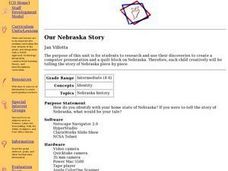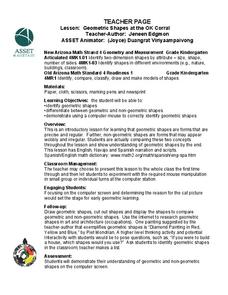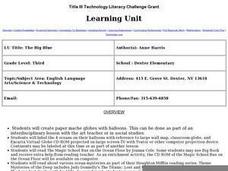Curated OER
The Sine Function
Students explore the concept of the sine function. In this sine function lesson, students use a plexiglass sine wave generator to visualize the sine function. Students use a computer program/calculator to adjust aspects of the sine...
Curated OER
3-D Figures Part 2
Students work with three dimensional objects. In this geometry lesson, students examine models of spheres, cones, cubes, prisms, and pyramids, and identify them by their edges, vertices, and faces.
Curated OER
Our Nebraska Story
Students research and use their discoveries to create a computer presentation and a quilt block on Nebraska. They will tell the story of Nebraska in an oral presentation using each piece of the quilt.
Curated OER
Microteaching
Tenth graders use the mathematical program, MATHEMATICA and graph linear and quadratic equations. They sketch the graph of an equation manually. Students compare their sketch with the computer generated model of the graph.
Curated OER
Butterfly Lifecycle
First graders examine diagrams of butterflies printed from the stated website and follow directions to make a model of the butterly life cycle. They then participate in a WebQuest to observe the life cycle stages of a butterfly.
Curated OER
Patterns
Second graders create an ABAB pattern with their name. For this early elementary math lesson, 2nd graders first model their names in an ABAB pattern with unifix cubes. They then recreate the pattern using letter stamps on KidPix.
National First Ladies' Library
Presidential Campaigning--Front Porch Style
High schoolers compare and contrast "front porch" political campaigns and modern day traveling campaigns of past presidents. Using the internet and other sources, they explore President Harding's campaign and platform. Using the internet...
Curated OER
Geometric Shapes at the OK Corral
Students explore geometric shapes. In this math lesson, students identify geometric and non-geometric shapes using the computer. Students research geometric shapes in art and architecture.
Curated OER
Our Favorite Pet
Students each have a turn, telling the class his or her favorite pet. The choices are cat, dog, fish or bird. Using the computer, the information from the tally be recorded on a spreadsheet and bar graph.
Curated OER
Constructing a Planetarium
Students work together to create their own planetarium. They observe the night sky and make a design. They also examine constellations and paint them onto the model of the planetarium.
Curated OER
Relational Causality
Young scholars explore volume and pressure. Through an activity, students discover what happens in situations when volume is increased but no additional air is able to enter the enclosed space. Young scholars create models and explain...
Curated OER
The Big Blue
Third graders create paper mache globes with balloons. They label the 4 oceans on their balloons with reference to large wall map, classroom globe, and Encarta Virtual Globe CD-ROM projected on large screen TV with Tvator or other...
Curated OER
Black Hawk and the Black Hawk Trail
Fourth graders investigate the American Indian tribe of Black Hawk and its trail. They use computers and a variety of technology resources to find information and put together a multimedia presentation. The end result is a storyboard...
Curated OER
'The Flood'
Students hear the story "The Flood," and take a survey of the favorite pet animals in the class. They take the information complied in the survey and make a bar graph to show favorite pet animals using the computer program KidPix.
Curated OER
Veterans Day Remembered
Sixth graders gather information about Veterans and create a PowerPoint. In this Veterans remembered lesson, 6th graders interview a veteran and research on the computer to create a five slide PowerPoint.
Curated OER
Down on the Farm
Learners are introduced to a map of an Illinois farm. They determine whether the map is of the past, present, or future by looking at features on the map. They also use the map to make a three-dimensional model.
Curated OER
Creative Expressions--Protein Synthesis
Students explore protein synthesis. They create a three dimensional, model of protein synthesis depicting all of the processes involved. Students create an oral presentation.
Curated OER
Stick To The Topic
Second graders engage in a lesson plan that is concerned with the increase of writing conventions. The teacher models the writing process for the students. The students work with the teacher to create a shared writing piece before the...
Curated OER
Backwards Goes It Does
Students create a three-dimensional model of the Chicago river watershed to determine the flow of the river at its mouth. They use prepared clear gelatin and topographic maps to discover that the building of canals actually reversed the...
Curated OER
Bermuda: Search for Deep Water Caves 2009: Out of Darkness
Learners analyze the three models on the origin of troglobitic fauna. In this life science lesson, students also consider how the Zonation model explains the fauna's origin. They also use the Internet to research solutional and volcanic...
Curated OER
The Derivation of (Pi)
Seventh graders groups measure the diameter and circumference of each of the circular objects in the room. They record their results on their student worksheets and access a computer spreadsheet program to compile their results.
Curated OER
Influence of Music On Our Lives: How Does Music Influence our Actions?
Eighth graders research how music influences our actions. They form an educated opinion of how music can influence our actions. Students create a computer generated presentation to outline the research methods used to form their answer....
Curated OER
Wild Things Are Here
Students engage in a literature study for the book Where The Wild Things Are. The skill of prediction is practiced as they preview the story as a whole class. The teacher models reading fluency, pronunciation, and phonetic skills while...
Curated OER
Fossils-Where Should We Place Archaeopteryx?
High schoolers explore an interactive computer activity that provides the opportunity to look at features of various groups of animals and determine where an extinct organism might be classified.























